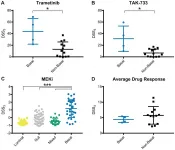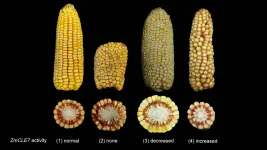(Press-News.org) February 22, 2021 - Widely used medications for benign prostatic hyperplasia (BPH) - also known as enlarged prostate - may be associated with a small, but significant increase in the probability of developing heart failure, suggests a study in The Journal of Urology®, Official Journal of the American Urological Association (AUA). The journal is pub lished in the Lippincott portfolio by Wolters Kluwer.
The risk is highest in men taking a type of BPH medication called alpha-blockers (ABs), rather than a different type called 5-alpha reductase inhibitors (5-ARIs), according to the new research by D. Robert Siemens, MD, and colleagues of Queen's University, Kingston, Ont., Canada. "While no one should stop taking their BPH medications based on these results, our study contributes new evidence for understanding the complex interaction of factors affecting heart disease risk in men with BPH," Dr. Siemens comments.
Do BPH drugs affect heart failure risk? New long-term, follow-up data
Benign prostatic hyperplasia is a very common condition in men, especially at older ages. It occurs when the prostate gland becomes enlarged, causing urinary symptoms (such as frequent and difficult urination). Millions of men take medications to reduce BPH symptoms - most commonly ABs, 5-ARIs, or a combination of the two.
Both BPH and cardiovascular disease are common in older men, which may reflect shared risk factors or causes. Clinical trials have suggested that men taking ABs or 5-ARIs might be more likely to develop heart failure: a chronic condition where the heart can't pump enough blood to keep up with demand. However, other studies have found no such link.
To clarify the association between BPH medications and heart failure, Dr. Siemens and colleagues used Ontario health data to identify more than 175,000 men diagnosed with BPH. About 55,000 patients were being treated with ABs alone, 8,000 with 5-ARIs alone, and 41,000 with a combination of ABs and 5-ARIs. The rest were not taking either type of BPH medication.
On analysis of follow-up data, men treated with ABs and/or 5-ARIs were more likely to be diagnosed with heart failure. The risk of developing heart failure were increased by 22 percent in men taking ABs alone, 16 percent for those taking combination therapy, and 9 percent for those taking 5-ARIs alone, compared to the control group of men not taking BPH medications. The associations were significant after adjusting for other characteristics, including heart disease risk factors.
Heart failure risk was higher with older "nonselective" ABs compared to newer "selective" ABs. Risk was higher in men taking ABs for a prolonged time: 14 months or longer.
Dr. Siemens and coauthors emphasize that while the increased probability of developing heart failure was statistically high, the absolute risk was relatively low. Risk factors such as previous heart disease, high blood pressure and diabetes had a much greater impact on heart failure risk compared to BPH medications. The researchers also note the control group of patients not taking 5-ARIs or ABs may have had less severe BPH symptoms, with possible differences in heart disease risk factors.
"Our study suggests men taking ABs and/or 5-ARIs are more likely to be diagnosed with heart failure," Dr. Siemens comments. "This is an important finding, given that BPH is so common among older men, and that these medications are so widely used."
Dr. Siemens adds: "Since men with BPH may continue these medications for several years, it is important physicians be aware of this risk, including both primary care physicians and urologists, perhaps especially in patients with previous heart disease or cardiovascular risk factors."
INFORMATION:
Click here to read "Cardiac Failure Associated with Medical Therapy of Benign Prostatic Hyperplasia: A Population-Based Study."
DOI: 10.1097/JU.0000000000001561
About The Journal of Urology®
The Official Journal of the American Urological Association (AUA), and the most widely read and highly cited journal in the field, The Journal of Urology® brings solid coverage of the clinically relevant content needed to stay at the forefront of the dynamic field of urology. This premier journal presents investigative studies on critical areas of research and practice, survey articles providing brief editorial comments on the best and most important urology literature worldwide and practice-oriented reports on significant clinical observations. The Journal of Urology® covers the wide scope of urology, including pediatric urology, urologic cancers, renal transplantation, male infertility, urinary tract stones, female urology and neurourology.
About the American Urological Association
Founded in 1902 and headquartered near Baltimore, Maryland, the American Urological Association is a leading advocate for the specialty of urology, and has nearly 24,000 members throughout the world. The AUA is a premier urologic association, providing invaluable support to the urologic community as it pursues its mission of fostering the highest standards of urologic care through education, research and the formulation of health care policy. To learn more about the AUA visit: http://www.auanet.org.
About Wolters Kluwer
Wolters Kluwer (WKL) is a global leader in professional information, software solutions, and services for the clinicians, nurses, accountants, lawyers, and tax, finance, audit, risk, compliance, and regulatory sectors. We help our customers make critical decisions every day by providing expert solutions that combine deep domain knowledge with advanced technology and services.
Wolters Kluwer reported 2019 annual revenues of €4.6 billion. The group serves customers in over 180 countries, maintains operations in over 40 countries, and employs approximately 19,000 people worldwide. The company is headquartered in Alphen aan den Rijn, the Netherlands.
Wolters Kluwer provides trusted clinical technology and evidence-based solutions that engage clinicians, patients, researchers and students with advanced clinical decision support, learning and research and clinical intelligence. For more information about our solutions, visit https://www.wolterskluwer.com/en/health and follow us on LinkedIn and Twitter @WKHealth.
For more information, visit http://www.wolterskluwer.com, follow us on Twitter, Facebook, LinkedIn, and YouTube.
Oncotarget recently published in "MEK is a promising target in the basal subtype of bladder cancer" by Merrill, et al. which reported that while many resources exist for the drug screening of bladder cancer cell lines in 2D culture, it is widely recognized that screening in 3D culture is more representative of in vivo response.
To address the need for 3D drug screening of bladder cancer cell lines, the authors screened 17 bladder cancer cell lines using a library of 652 investigational small-molecules and 3 clinically relevant drug combinations in 3D cell culture.
Their goal was to identify compounds and classes of compounds with efficacy in bladder cancer.
Utilizing ...
An international team of scientists, including two from Oregon State University, conducted a biological assessment of the world's rivers and the limited data they found presents a fairly bleak picture.
"For the places that we have data, the situations are not really that good. There are many species that are declining, threatened or endangered," said Bob Hughes, co-author of the paper and a courtesy associate professor in Oregon State's Department of Fisheries and Wildlife. "But for most of the globe, there just is little rigorous data."
The work by Hughes and the ...
By analyzing 50 years' worth of coral reef biodiversity studies, researchers reporting in the journal Current Biology on February 22 have quantified the practice of "parachute science," which happens when international scientists, typically from higher-income countries, conduct field studies in another, typically lower-income country, without engaging with local researchers. They found that institutions from several lower-middle- and upper-middle-income countries with abundant coral reefs produced less research than institutions based in high-income countries with fewer or in some cases no reefs. They also found that host-nation scientists (scientists from the nations where field research was conducted) were ...
Corn--or maize--has changed over thousands of years from weedy plants that make ears with less than a dozen kernels to the cobs packed with hundreds of juicy kernels that we see on farms today. Powerful DNA-editing techniques such as CRISPR can speed up that process. Cold Spring Harbor Laboratory (CSHL) Professor David Jackson and his postdoctoral fellow Lei Liu collaborated with University of Massachusetts Amherst Associate Professor Madelaine Bartlett to use this highly specific technique to tinker with corn kernel numbers. Jackson's lab is one of the first to apply CRISPR to corn's very complex ...
Tracing back a ghostly particle to a shredded star, scientists have uncovered a gigantic cosmic particle accelerator. The subatomic particle, called a neutrino, was hurled towards Earth after the doomed star came too close to the supermassive black hole at the centre of its home galaxy and was ripped apart by the black hole's colossal gravity. It is the first particle that can be traced back to such a 'tidal disruption event' (TDE) and provides evidence that these little understood cosmic catastrophes can be powerful natural particle accelerators, as the team led by DESY scientist Robert Stein reports in the journal Nature Astronomy. The observations also demonstrate the power of exploring the cosmos via ...
A new study from UCLA and Stanford University researchers finds that three-dimensional human stem cell-derived 'mini brain' organoids can mature in a manner that is strikingly similar to human brain development.
For the new study, published in Nature Neuroscience February 22, senior authors Dr. Daniel Geschwind of UCLA and Dr. Sergiu Pasca of Stanford University conducted extensive genetic analysis of organoids that had been grown for up to 20 months in a lab dish. They found that these 3D organoids follow an internal clock that guides their maturation in sync with the timeline of human development.
"This is novel -- Until now, nobody has grown and characterized these organoids for this amount of time, nor shown they will recapitulate human brain development in a laboratory environment ...
A two-metre-long painting of a kangaroo in Western Australia's Kimberley region has been identified as Australia's oldest intact rock painting.
Using the radiocarbon dating of 27 mud wasp nests, collected from over and under 16 similar paintings, a University of Melbourne collaboration has put the painting at 17,500 and 17,100 years old.
"This makes the painting Australia's oldest known in-situ painting," said Postdoctoral Researcher Dr Damien Finch who pioneered the exciting new radiocarbon technique.
"This is a significant find as through these initial estimates, we can understand something of the ...
What The Study Did: Using COVID-19 data, this observational study looked at what are the independent associations of voluntary behavioral change and legal restrictions, such as state-mandated school closings, with the subsequent spread of the COVID-19 pandemic in the U.S.
Authors: Frederick J. Zimmerman, Ph.D., of the Fielding School of Public Health at UCLA in Los Angeles, is the corresponding author.
To access the embargoed study: Visit our For The Media website at this link https://media.jamanetwork.com/
(doi:10.1001/jamapediatrics.2020.6371)
Editor's Note: The article includes ...
A team of scientists has detected the presence of a high-energy neutrino--a particularly elusive particle--in the wake of a star's destruction as it is consumed by a black hole. This discovery, reported in the journal Nature Astronomy, sheds new light on the origins of Ultrahigh Energy Cosmic Rays--the highest energy particles in the Universe.
The work, which included researchers from more than two dozen institutions, including New York University and Germany's DESY research center, focused on neutrinos--subatomic particles that are produced on Earth only in powerful ...
What The Study Did: Researchers examined changes in trauma admissions throughout Los Angeles County during the COVID-19 pandemic in California.
Authors: Kazuhide Matsushima, M.D., of the University of Southern California in Los Angeles, is the corresponding author.
To access the embargoed study: Visit our For The Media website at this link https://media.jamanetwork.com/
(doi:10.1001/jamanetworkopen.2021.1320)
Editor's Note: The article includes funding/support disclosures. Please see the article for additional information, including other authors, author contributions and affiliations, conflict of interest and financial disclosures, ...




